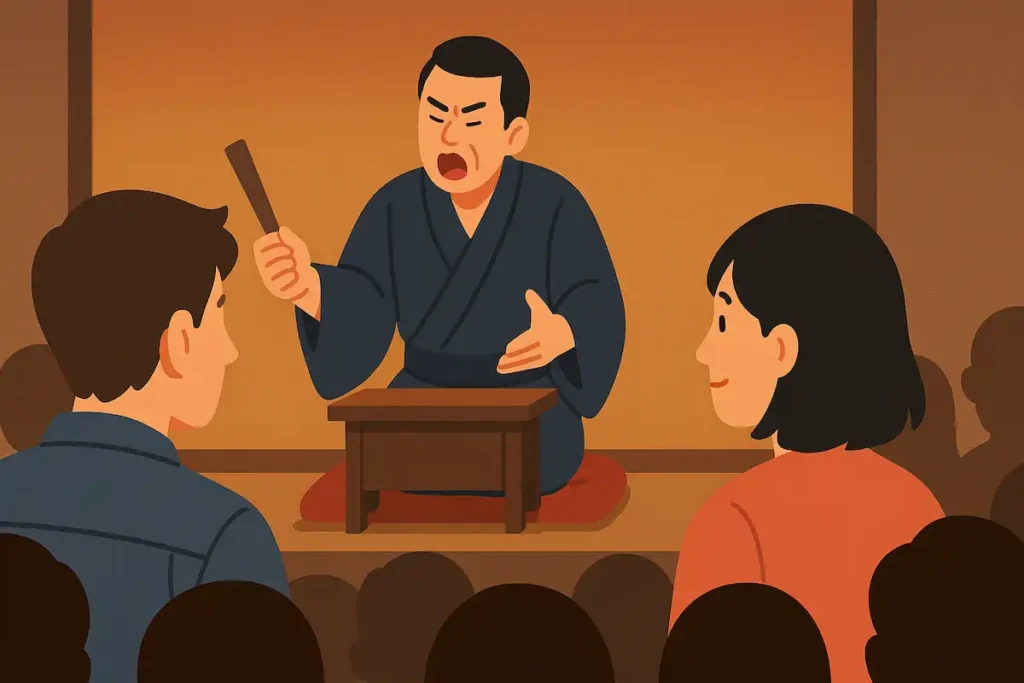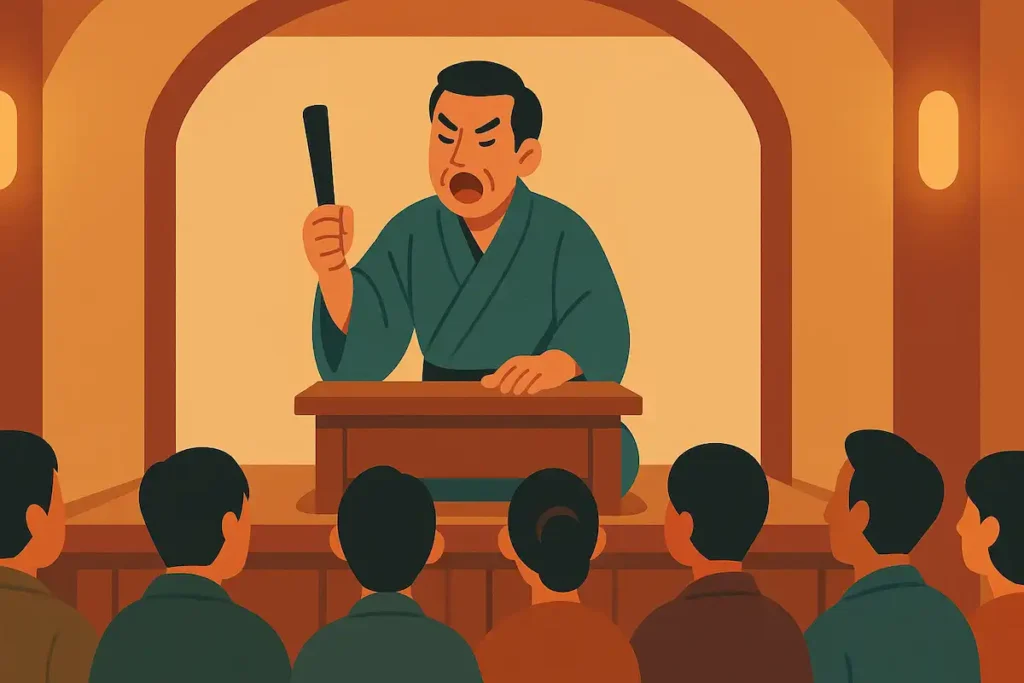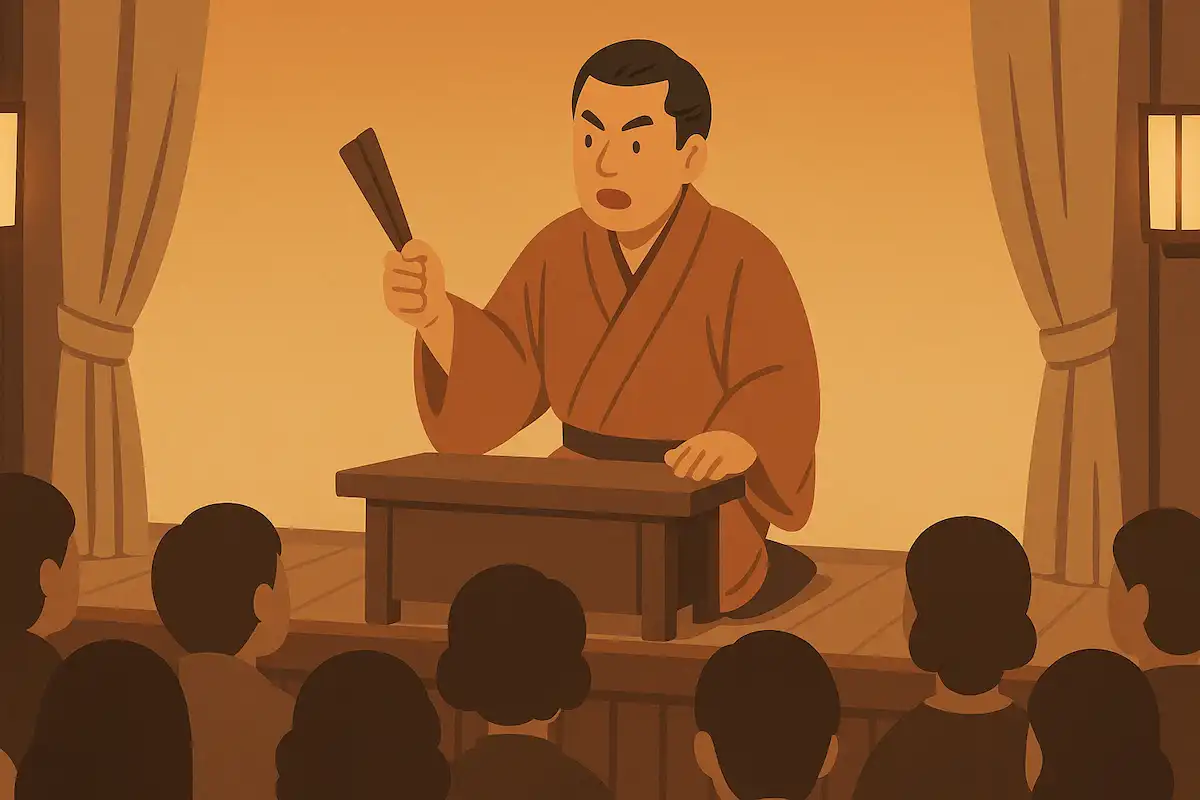講談を英語で説明・紹介するための基本情報と、英会話に役立つ表現をシンプルでわかりやすい英語で紹介します。
英会話ダイアローグ・概要・10の質問を通して、講談に関する英語表現を学びます。
英語
英会話ダイアローグを読む前に知っておくと良い前提知識と情報です。
- 講談の基本
- 歴史上の事件や戦記物、武士の忠義などの英雄的な物語を、調子(リズム)をつけて語る話芸
- 物語の臨場感やドラマ性を高めるために、大げさな表現や強い声色が使われる
- 忠義、正義、勇気といった道徳的・教訓的な価値が中心
- 講談の特徴と魅力
- 声の力とリズム感が最大の特徴、張り扇で机を叩く音が、場面の切り替えや緊張感を生み出す
- 登場人物のセリフもすべて講談師一人で語るため、感情表現と間の使い方が非常に重要
- 鑑賞できる場所
- 寄席と呼ばれる演芸場で講談を鑑賞できる
- 東京では上野や新宿の寄席が有名で、落語や漫才なども一緒に楽しめる
- 講談と落語の違い
- 落語: 日常生活や庶民の失敗談などをユーモラスに語る、オチ(サゲ)が重要
- 講談: 主に歴史や教訓を扱い、声やリズムでドラマチックに物語を進める、感動や緊張感が中心
- 現代の講談と人気の復活
- 近年では、神田伯山などの人気講談師が活躍、若い世代にも関心が広がっている
- 「新作講談」として現代の出来事や人物を題材にした作品も登場
2人が講談について話しています。
講談の起源や特徴、魅力、現代での人気の高まりなどを話題にしています。
会話 / dialogue

Hey Key, have you ever watched Kōdan before? I saw a clip online, and it looked really powerful.

Oh, nice! Yes, I’ve seen a few performances. Kōdan is a traditional Japanese storytelling art — it’s quite dramatic, isn’t it?

Yeah! The storyteller was sitting behind a small desk and hitting it with a fan. What was that all about?

That’s part of the performance. The storyteller, called a Kōdanshi, uses a fan called harisen to strike the desk, or shakudai, to create rhythm and tension.

Interesting! It reminded me of music. Every strike seemed to match the emotion of the story.

Exactly. Kōdan is known for its rhythm, voice control, and dramatic timing. It’s like a one-person theater using only words and sound.

What kind of stories do they tell?

Most stories are about famous samurai, battles, loyalty, or justice. For example, Chūshingura, the tale of the forty-seven loyal samurai, is one of the most popular.

Oh, I’ve heard of that! So it’s not comedy like rakugo, right?

Right, good point. While rakugo is more humorous and everyday, Kōdan focuses on heroic and historical tales — more serious and inspiring.

I like that. It feels intense and full of passion. The storyteller’s voice was so strong!

That’s one of Kōdan’s most amazing points — the power of the voice. A great Kōdanshi can make you imagine battles or emotions just by speaking.

So there are no props or actors, only one storyteller?

Yes, just one. But you can picture everything clearly — the sound of swords, the emotion in people’s hearts — it’s incredible.

That sounds like a mix of art and history. Is it still popular today?

Actually, yes! Thanks to performers like Kanda Hakuzan, Kōdan is becoming popular again, especially among young people.

Really? I didn’t expect that. I thought it was something only older people enjoyed.

It used to be, but now Kōdan appears on TV, podcasts, and even YouTube. Some storytellers create new stories about modern life too.

That’s cool! I love how traditional arts can adapt to modern times.

Exactly — that’s part of its charm. Kōdan keeps the old samurai spirit but connects it to our lives today.

I like that message — courage, loyalty, justice. Those values are timeless.

Yes, and that’s why people say Kōdan is more than entertainment. It teaches moral lessons and touches your heart.

It sounds like something worth experiencing live. Do you know where I can watch it?

Sure! You can go to yose theaters in Tokyo, like in Ueno or Shinjuku. There are also special performances and events.

Great, I’d love to go. Maybe we can go together sometime?

Absolutely! Once you see it live — the rhythm, the emotion, the atmosphere — you’ll understand why Kōdan is so special.
概要(講談とは?歴史・特徴・魅力・現代の人気)
「講談」について、理解を深めるための「英語での概要」です。
講談

What Is Kōdan?
Kōdan is a traditional Japanese form of storytelling that began in the Edo period (1603–1868). A storyteller, called a Kōdanshi, sits behind a small wooden desk called a shakudai and tells stories about samurai, history, and human values. The storyteller uses a folding fan, or harisen, to hit the desk to create rhythm, surprise, and emotion. The sound helps to make the story more powerful and dramatic.
The Style and Features
In Kōdan, the storyteller uses only their voice and body language to bring the story to life. They control the rhythm, tone, and timing carefully. The stories are often about loyalty, bravery, and justice — values that were important in samurai culture. Even without music or pictures, the storyteller makes the audience imagine battles, emotions, and scenes vividly in their minds.
Why Kōdan Is Special
Kōdan is not just entertainment; it also teaches lessons about life and morality. The performer’s voice can express deep emotion and move the audience’s heart. Each performance feels different because the storyteller reacts to the audience, creating a strong human connection.
Kōdan Today
In modern times, performers like Kanda Hakuzan have made Kōdan popular again through TV, radio, and YouTube. Some storytellers even create new Kōdan stories about modern life. Kōdan continues to connect Japan’s past and present, keeping the spirit of Japanese storytelling alive.
10の質問(講談の基本知識)
「講談」について、理解を深めるための「英語での10の質問」です。
1: What is Kōdan?
Kōdan is a traditional Japanese form of storytelling. A performer, called a Kōdanshi, tells stories about history, samurai, or moral lessons while sitting behind a small desk.
2: When did Kōdan begin?
Kōdan began in the Edo period (1603–1868). It was popular among common people as entertainment and a way to learn about history and good values.
3: Who performs Kōdan?
Kōdan is performed by storytellers called Kōdanshi. They train for many years to learn how to speak with rhythm, emotion, and power.
4: What tools are used in Kōdan?
The storyteller uses a small wooden desk called a shakudai and a folding fan called a harisen. The fan is used to hit the desk and make a strong, dramatic sound.
5: What are the main themes of Kōdan stories?
The stories are usually about loyalty, bravery, and justice. Many come from samurai legends or historical events.
6: How is Kōdan different from Rakugo?
Rakugo is more humorous and tells funny daily stories, while Kōdan is serious and focuses on heroic and historical tales.
7: Why is Kōdan special?
Kōdan is special because it uses only the storyteller’s voice and rhythm to make the audience imagine the whole scene. It shows the power of words and emotion.
8: Is Kōdan still popular today?
Yes. Thanks to modern performers like Kanda Hakuzan, Kōdan is becoming popular again, especially among younger generations.
9: Where can people watch Kōdan performances?
People can watch Kōdan at yose theaters in cities like Tokyo and Osaka, or at special events and performances.
10: What does Kōdan teach us?
Kōdan teaches lessons about courage, loyalty, and human spirit. It reminds us of the importance of values that never change over time.

和訳付
会話 / dialogue

Hey Key, have you ever watched Kōdan before? I saw a clip online, and it looked really powerful.
ねえキー、講談って見たことある? ネットで動画を見たんだけど、すごく迫力があったんだ。

Oh, nice! Yes, I’ve seen a few performances. Kōdan is a traditional Japanese storytelling art — it’s quite dramatic, isn’t it?
いいね!うん、何回か見たことあるよ。講談は日本の伝統的な話芸で、すごくドラマチックだよね。

Yeah! The storyteller was sitting behind a small desk and hitting it with a fan. What was that all about?
そうそう!語り手が小さな机の後ろに座って、扇で叩いてたけど、あれって何?

That’s part of the performance. The storyteller, called a Kōdanshi, uses a fan called harisen to strike the desk, or shakudai, to create rhythm and tension.
あれは講談の演出の一部なんだ。語り手は「講談師」って呼ばれてて、張り扇(はりおうぎ)っていう扇で釈台(しゃくだい)を叩いて、リズムや緊張感を作るんだよ。

Interesting! It reminded me of music. Every strike seemed to match the emotion of the story.
面白いね!なんだか音楽みたいだったよ。叩くタイミングが物語の感情にぴったり合ってた。

Exactly. Kōdan is known for its rhythm, voice control, and dramatic timing. It’s like a one-person theater using only words and sound.
そのとおり。講談はリズムや声の抑揚、タイミングが命なんだ。言葉と音だけで演じる一人芝居みたいなものだよ。

What kind of stories do they tell?
どんな話をするの?

Most stories are about famous samurai, battles, loyalty, or justice. For example, Chūshingura, the tale of the forty-seven loyal samurai, is one of the most popular.
有名な武士の話とか、戦い、忠義や正義の物語が多いね。たとえば「忠臣蔵」は代表的な演目のひとつだよ。

Oh, I’ve heard of that! So it’s not comedy like rakugo, right?
あ、それ聞いたことある!じゃあ、落語みたいなコメディじゃないんだね?

Right, good point. While rakugo is more humorous and everyday, Kōdan focuses on heroic and historical tales — more serious and inspiring.
そうそう、いいところに気づいたね。落語はユーモラスで日常的だけど、講談はもっと勇敢で歴史的な物語を語るんだ。真面目で感動的なんだよ。

I like that. It feels intense and full of passion. The storyteller’s voice was so strong!
それ、いいね。迫力があって情熱的だし、語り手の声がすごく力強かった!

That’s one of Kōdan’s most amazing points — the power of the voice. A great Kōdanshi can make you imagine battles or emotions just by speaking.
そこが講談のすごいところなんだよ。声の力だけで、戦いや人の感情まで想像させるんだ。

Mack: So there are no props or actors, only one storyteller?
じゃあ、道具とか俳優はいなくて、語り手だけなの?

Yes, just one. But you can picture everything clearly — the sound of swords, the emotion in people’s hearts — it’s incredible.
そう、たった一人。でもね、刀の音や人の心の動きまで頭に浮かぶんだよ。ほんとにすごいんだ。

That sounds like a mix of art and history. Is it still popular today?
芸術と歴史が融合してる感じだね。今でも人気があるの?

Actually, yes! Thanks to performers like Kanda Hakuzan, Kōdan is becoming popular again, especially among young people.
実はあるんだよ!神田伯山さんみたいな人気講談師のおかげで、特に若い世代の間でまた注目されてるんだ。

Really? I didn’t expect that. I thought it was something only older people enjoyed.
ほんとに?意外だな。年配の人が見るものだと思ってたよ。

It used to be, but now Kōdan appears on TV, podcasts, and even YouTube. Some storytellers create new stories about modern life too.
昔はそうだったけど、今はテレビやポッドキャスト、YouTubeにも出てるよ。現代の出来事を題材にした新作講談もあるんだ。

That’s cool! I love how traditional arts can adapt to modern times.
それはいいね!伝統芸能が現代に合わせて進化してるのって素敵だよね。

Exactly — that’s part of its charm. Kōdan keeps the old samurai spirit but connects it to our lives today.
まさにそれ。古い武士道の精神を残しながら、今の時代ともちゃんとつながってるんだ。

I like that message — courage, loyalty, justice. Those values are timeless.
そのメッセージ、いいね。勇気とか忠義とか正義って、時代が変わっても大切だよね。

Yes, and that’s why people say Kōdan is more than entertainment. It teaches moral lessons and touches your heart.
そうなんだ。だから講談はただの娯楽じゃなくて、生き方の教訓を教えてくれるって言われてるんだよ。

It sounds like something worth experiencing live. Do you know where I can watch it?
生で見てみる価値ありそうだね。どこで見られるか知ってる?

Sure! You can go to yose theaters in Tokyo, like in Ueno or Shinjuku. There are also special performances and events.
もちろん!東京なら上野とか新宿の寄席で見られるよ。特別公演もあるしね。

Great, I’d love to go. Maybe we can go together sometime?
いいね!ぜひ行ってみたいな。今度一緒に行こうよ。

Absolutely! Once you see it live — the rhythm, the emotion, the atmosphere — you’ll understand why Kōdan is so special.
もちろん!生で見たら、リズムや感情、雰囲気のすごさがわかるよ。講談が特別な理由がきっと実感できるはず。
概要(講談とは?歴史・特徴・魅力・現代の人気)
講談

What Is Kōdan?
Kōdan is a traditional Japanese form of storytelling that began in the Edo period (1603–1868). A storyteller, called a Kōdanshi, sits behind a small wooden desk called a shakudai and tells stories about samurai, history, and human values. The storyteller uses a folding fan, or harisen, to hit the desk to create rhythm, surprise, and emotion. The sound helps to make the story more powerful and dramatic.
講談は、江戸時代(1603〜1868)に始まった日本の伝統的な語り芸です。
講談師と呼ばれる語り手が「釈台(しゃくだい)」と呼ばれる小さな木の机の後ろに座り、武士や歴史、人の生き方などをテーマにした物語を語ります。
語り手は「張り扇(はりおうぎ)」という扇を使って机を叩き、リズムや驚き、感情を表現します。
この音が物語に力強さと緊張感を与えます。
The Style and Features
In Kōdan, the storyteller uses only their voice and body language to bring the story to life. They control the rhythm, tone, and timing carefully. The stories are often about loyalty, bravery, and justice — values that were important in samurai culture. Even without music or pictures, the storyteller makes the audience imagine battles, emotions, and scenes vividly in their minds.
講談では、語り手は声と身ぶりだけで物語に命を吹き込みます。
リズムや声の調子、話すタイミングを細かくコントロールします。
物語の多くは「忠義」「勇気」「正義」といった、武士の文化で大切にされた価値をテーマにしています。
音楽や映像がなくても、講談師の語りによって観客は戦いや感情の場面を頭の中に鮮やかに思い描けます。
Why Kōdan Is Special
Kōdan is not just entertainment; it also teaches lessons about life and morality. The performer’s voice can express deep emotion and move the audience’s heart. Each performance feels different because the storyteller reacts to the audience, creating a strong human connection.
講談は単なる娯楽ではなく、人生や道徳についての教えを伝える芸です。
語り手の声には深い感情が込められ、聴く人の心を動かします。
また、講談師は観客の反応を感じ取りながら語るため、毎回違ったライブ感があり、人と人との強いつながりを生みます。
Kōdan Today
In modern times, performers like Kanda Hakuzan have made Kōdan popular again through TV, radio, and YouTube. Some storytellers even create new Kōdan stories about modern life. Kōdan continues to connect Japan’s past and present, keeping the spirit of Japanese storytelling alive.
現代では、神田伯山などの講談師の活躍によって、講談は再び注目を集めています。
テレビ、ラジオ、YouTubeなどを通じて若い世代にも人気が広がっています。
中には現代社会を題材にした新作講談を作る講談師もいます。
講談は日本の過去と現在をつなぎ、「語りの文化」の精神を今も生き続けさせています。
10の質問(講談の基本知識)
1: What is Kōdan?
講談とは何ですか?
Kōdan is a traditional Japanese form of storytelling. A performer, called a Kōdanshi, tells stories about history, samurai, or moral lessons while sitting behind a small desk.
講談は日本の伝統的な語り芸です。講談師と呼ばれる語り手が、小さな机の後ろに座り、歴史や武士、道徳的な教えに関する物語を語ります。
2: When did Kōdan begin?
講談はいつ始まりましたか?
Kōdan began in the Edo period (1603–1868). It was popular among common people as entertainment and a way to learn about history and good values.
講談は江戸時代(1603〜1868)に始まりました。庶民の娯楽として、また歴史や道徳を学ぶ手段として人気がありました。
3: Who performs Kōdan?
講談を演じるのは誰ですか?
Kōdan is performed by storytellers called Kōdanshi. They train for many years to learn how to speak with rhythm, emotion, and power.
講談は「講談師」と呼ばれる語り手によって演じられます。彼らはリズムや感情、力強い話し方を身につけるために、長年の修行を積みます。
4: What tools are used in Kōdan?
講談ではどんな道具が使われますか?
The storyteller uses a small wooden desk called a shakudai and a folding fan called a harisen. The fan is used to hit the desk and make a strong, dramatic sound.
講談師は「釈台(しゃくだい)」と呼ばれる小さな机と、「張り扇(はりおうぎ)」という扇を使います。扇で机を叩き、力強く印象的な音を出します。
5: What are the main themes of Kōdan stories?
講談の主なテーマは何ですか?
The stories are usually about loyalty, bravery, and justice. Many come from samurai legends or historical events.
講談の物語は、忠義・勇気・正義などをテーマにしています。多くは武士の伝説や歴史的な出来事に基づいています。
6: How is Kōdan different from Rakugo?
講談は落語とどう違いますか?
Rakugo is more humorous and tells funny daily stories, while Kōdan is serious and focuses on heroic and historical tales.
落語はユーモラスで日常的な話を中心にしていますが、講談はより真剣で、英雄的・歴史的な物語に焦点を当てます。
7: Why is Kōdan special?
講談の特別な点は何ですか?
Kōdan is special because it uses only the storyteller’s voice and rhythm to make the audience imagine the whole scene. It shows the power of words and emotion.
講談の特別な点は、語り手の声とリズムだけで聴き手に情景を思い浮かばせることです。言葉と感情の力を示しています。
8: Is Kōdan still popular today?
講談は今でも人気がありますか?
Yes. Thanks to modern performers like Kanda Hakuzan, Kōdan is becoming popular again, especially among younger generations.
はい。神田伯山(かんだはくざん)のような現代の講談師のおかげで、特に若い世代の間で再び人気が高まっています。
9: Where can people watch Kōdan performances?
講談はどこで見ることができますか?
People can watch Kōdan at yose theaters in cities like Tokyo and Osaka, or at special events and performances.
講談は、東京や大阪の寄席(よせ)や特別公演・イベントなどで見ることができます。
10: What does Kōdan teach us?
講談は私たちに何を教えてくれますか?
Kōdan teaches lessons about courage, loyalty, and human spirit. It reminds us of the importance of values that never change over time.
講談は、勇気・忠義・人の心の強さといった教えを伝えてくれます。時代が変わっても大切な価値観の重要さを思い出させてくれます。

words & phrases
英会話ダイアローグと関連情報に出てきた単語・フレーズです(例文は各3つ)。

clip : 名詞 /klɪp/
意味: (短い)映像・動画の一部。A short segment of a video or film.
例文:
- I watched a short clip of a Kōdan performance on YouTube.
「YouTubeで講談の短い映像を見ました。」 - The news showed a clip from last night’s performance.
「ニュースで昨夜の公演の映像が流れました。」 - She shared a funny clip with her friends.
「彼女は友達に面白い動画をシェアしました。」
humorous : 形容詞 /ˈhjuː.mə.rəs/
意味: ユーモアのある、おかしみのある。Funny or showing a sense of humor.
例文:
- Rakugo is a humorous form of storytelling.
「落語はユーモアのある話芸です。」 - He told a humorous story about his childhood.
「彼は子どもの頃の面白い話をしました。」 - The movie was light and humorous, perfect for a relaxing night.
「その映画は軽くてユーモラスで、くつろぐ夜にぴったりでした。」
heroic : 形容詞 /hɪˈroʊ.ɪk/
意味: 勇敢な、英雄的な。Very brave or showing great courage.
例文:
- The samurai in Kōdan stories often perform heroic deeds.
「講談の侍たちはしばしば英雄的な行動をします。」 - It was a heroic effort to save the village.
「村を救うための勇敢な努力でした。」 - His heroic attitude inspired everyone around him.
「彼の勇敢な姿勢は周りの人々に感動を与えました。」
prop : 名詞 /prɑːp/(英) /prɒp/(米)
意味: 舞台や演技に使う小道具。An object used by actors or performers during a play or performance.
例文:
- The storyteller uses almost no props in Kōdan.
「講談ではほとんど小道具を使いません。」 - The fan is the only prop used during the performance.
「公演で使われる唯一の小道具は扇です。」 - The actor forgot his props backstage.
「俳優は舞台裏に小道具を忘れました。」
timeless : 形容詞 /ˈtaɪm.ləs/
意味: 時代を超えて価値のある、永遠の。Not affected by time; always valuable or relevant.
例文:
- The message of Kōdan stories is timeless.
「講談の物語のメッセージは時代を超えています。」 - Her beauty and grace are timeless.
「彼女の美しさと優雅さは永遠です。」 - Traditional arts have a timeless appeal.
「伝統芸能には時代を超えた魅力があります。」
